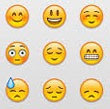emoji
 a.k.a. emojicons, diverse emojis, humoticons, graphical smileys
a.k.a. emojicons, diverse emojis, humoticons, graphical smileys (pronounced: ee-moh-gee)
A next-generation version of the emoticon, it's a picture that enables the replacement of text smileys. Emojis were initially used in instant messaging programs, they are also widely seen in text messages.
A "humoticon" is another variation on the emoticon by trying to integrate the emoticon's more humanistic counterpart: you.
Historical perspective: Emojis were originally developed by Shigetaka Kurita, who engineered the expressive reaction faces around the time Windows 95 first began taking off in Japan. In 2010, they were added to the Unicode Standard in other countries, including the United States.
In 2015, the term "emoji" was added to Merriam-Webster's dictionary. Also in 2015, the Unicode Consortium introduced "diverse" emojis, including gay and lesbian parents, more gender combinations of sons and daughters, and the default color of "Lego People" yellow. Now users have the option of modifying the skin colors with a selection of five hues based on a skin-tone scale used by dermatologists.
"Ginger emojis" or those representing people with red hair, were finally added in 2018 due to a lobbying effort from Scotland where 13% of the population is red-haired. By 2024, a poll found that 41 percent of Americans believe that a text message feels naked unless it includes at least one emoji, and 70 percent of Gen Z people feel this way.


Edit Word